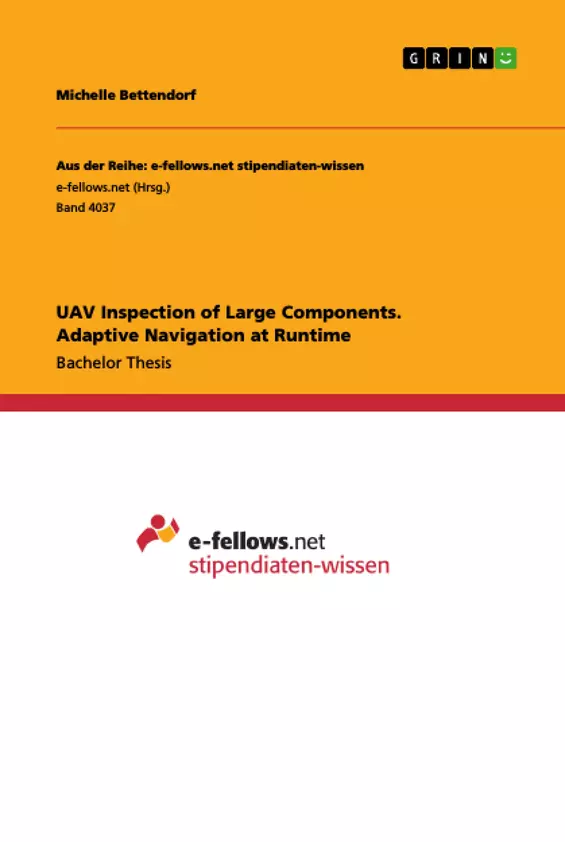In this thesis, two problems are covered. The first one is to estimate the position of a drone out of two different given transformations, which don’t have the same coordinate origin. Furthermore, measurement errors have to be outbalanced so that the position estimation is as accurate as possible. In order to solve this problem, a Kalman Filter was utilized.
The second problem is to direct the drone to given goal positions while avoiding obstacles. For directing the drone to the desired location a vector flight control with temporary goals was created. The vector flight control is working online and is constantly using the current estimated position of the Kalman Filter in order to direct the drone correctly at each time. This thesis is covering the concept, the implementation and evaluation of these algorithms.
Inhaltsverzeichnis (Table of Contents)
- Problem definition
- Related work
- Basics
- Quadrocopter
- Frames
- Quaternions
- Robot Operating System
- Unified Robot Description Format
- Kalman Filter
- Extended Kalman Filter
- Unscented Kalman Filter
- Trajectory planning
- Potential Field
- Concept
- Sensor Fusion of drone odometry and inspection software
- Vector Flight Control
- Architecture Overview
- Implementation
- Kalman Filter Implementation
- Existing libraries
- Simulation
- Realization
- Potential Field Method Implementation
- Existing libraries
- Realization
- Kalman Filter Implementation
- Proof of Concept
- Sensor Fusion Evaluation
- Vector Flight Control Evaluation
- Evaluation of the combined architecture
- Conclusion and Future Work
Zielsetzung und Themenschwerpunkte (Objectives and Key Themes)
This thesis explores the automation of ship hull inspections using a drone, addressing two key problems: accurate position estimation using sensor fusion and the creation of a collision-free trajectory for the drone. The goal is to develop and evaluate algorithms for both tasks, including sensor data fusion, trajectory planning, and drone control.
- Sensor fusion of drone odometry and camera data for accurate position estimation.
- Development of a vector flight control system for drone navigation.
- Trajectory planning for navigating the drone through predefined inspection points.
- Implementation and evaluation of the developed algorithms in a real-world setting.
- Exploration of the challenges and limitations of drone-based inspection automation.
Zusammenfassung der Kapitel (Chapter Summaries)
- Chapter 1: Problem definition: This chapter introduces the problem of automating ship hull inspections, highlighting the need for accurate position estimation, trajectory planning, and collision avoidance. It outlines the specific challenges related to sensor fusion, trajectory planning, and drone control.
- Chapter 2: Related work: This chapter reviews existing research on drone-based inspection, sensor fusion, and trajectory planning, providing context for the current study and identifying gaps in the literature.
- Chapter 3: Basics: This chapter provides essential background information on key concepts such as quadrocopters, frames, quaternions, the Robot Operating System (ROS), and the Unified Robot Description Format (URDF). It also discusses relevant concepts like Kalman filtering and potential field methods.
- Chapter 4: Concept: This chapter presents the conceptual framework for the proposed solution, outlining the approaches to sensor fusion, vector flight control, and the overall system architecture.
- Chapter 5: Implementation: This chapter details the implementation of the proposed algorithms, including the Kalman filter implementation, existing libraries used, simulation and realization aspects, and the implementation of the potential field method.
- Chapter 6: Proof of Concept: This chapter describes the evaluation of the implemented algorithms, including the sensor fusion evaluation, vector flight control evaluation, and the combined architecture evaluation.
Schlüsselwörter (Keywords)
This thesis focuses on the application of drone technology for automated ship hull inspections, utilizing sensor fusion techniques, trajectory planning algorithms, and vector flight control. Key concepts include drone odometry, camera-based position estimation, Kalman filtering, potential field methods, ROS framework, and collision avoidance.
- Citation du texte
- Michelle Bettendorf (Auteur), 2019, UAV Inspection of Large Components. Adaptive Navigation at Runtime, Munich, GRIN Verlag, https://www.grin.com/document/1162994



